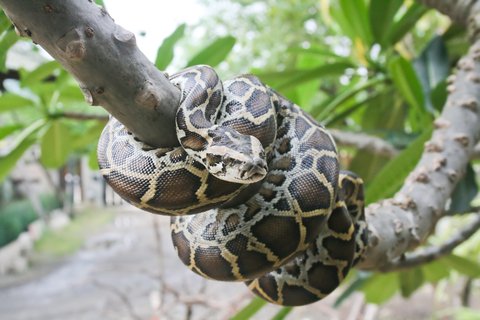
Florida has a major python problem. For decades, Burmese pythons have been taking over the Florida Everglades, choking out native species and wreaking havoc on the ecosystem.
For residents living in South Florida where the invasive species primarily reside, there are local python hunters that can take care of any that might seek refuge in a cabinet or crawl space. There is even a reality television show about them called Python Hunters.
As a way to raise further awareness and thin the ranks, Florida wildlife officials are planning a “python challenge” next year similar to a promotion held in 2013. That year the Florida Fish and Wildlife Conservation Commission offered $1,600 to the python hunter who could bag the biggest serpent.
A total of 68 pythons were taking during the month-long competition two years ago. While officials said it did not make a huge impact on the overall numbers – an estimated 1,600 Burmese pythons are roaming wild – it did help raise the issue. Burmese pythons first started showing up in the Florida Everglades in the 1980s, likely from a pet snake that was released or got loose. It’s currently illegal to own a python in Florida.
The challenge “gives the public the opportunity to get involved in solving the problem or at least thinking they’re solving the problem,” University of Florida wildlife biologist Frank Mazzotti told the Miami Herald.
Burmese pythons can grow as long as 16 feet and weigh more than 100 pounds. They also have a voracious appetite, consuming just about anything. A recent analysis of the 68 pythons taken in 2013 showed mostly consumed small mammals such as rats and rabbits along with nearly an equal percent of water birds. And some even ate some alligators, according to a recent study reported in the Orlando Sentinel.
An ongoing program called the “Python Patrol” instructs local outdoors enthusiasts how to trap any Burmese pythons they might encounter in the wild. Airboat captain in the Florida Everglades, Ozzie Gonzalez told The Guardian he sees them all the time.
“They are everywhere you look,” Gonzalez told the paper. “It’s become a real problem in just the last few years. The conditions are perfect for them to reproduce, and they eat anything they can.”
In addition to the Burmese python, now another species called the rock python is believed to be spreading, according to experts. Unlike the Bumrese, however, the rock python has stayed to a relatively confined area. After a rock python strangled a Siberian Husky.








